Sup Mang Cua, a tantalizing dish that combines the delicate essence of asparagus with the succulent goodness of crab. This Asian delicacy takes the classic soup to new heights, offering a harmonious blend of flavors that will captivate your taste buds.
Join us as we embark on a culinary journey to explore the nuances, preparation techniques, and cultural significance of this beloved soup. Get ready to savor the extraordinary blend of asparagus and crab in every spoonful of Sup Mang Cua.
What is sup mang cua?
Sup Mang Cua is a Vietnamese delicacy that refers to asparagus soup with crab. This delectable dish is a perfect marriage of fresh asparagus and succulent crab meat, resulting in a flavorful and aromatic soup.
With its origins deeply rooted in Vietnamese cuisine, Sup Mang Cua holds cultural significance and is often served during special occasions and family gatherings. The dish showcases the use of locally available ingredients and reflects the emphasis on freshness and balance in Vietnamese cooking.
Over time, Sup Mang Cua has gained popularity not only within Vietnam but also among food enthusiasts worldwide. Its unique combination of asparagus and crab offers a delightful blend of textures and flavors. The asparagus lends a subtle, earthy taste, while the crab meat adds a luxurious richness. This exquisite pairing has captured the attention and taste buds of those seeking a harmonious and satisfying dining experience.
Sup Mang Cua carries a rich historical background, with stories tracing back to ancient Vietnamese culinary traditions. The soup has become ingrained in local customs, often associated with celebrations, festivals, and family reunions. It symbolizes abundance, togetherness, and the joy of sharing a nourishing meal.
Indulge in the stories and anecdotes that surround Sup Mang Cua as you delve into the cultural tapestry woven around this beloved Vietnamese dish. Experience the traditions, flavors, and warmth that make Sup Mang Cua a cherished part of Vietnamese culinary heritage.
What does sup mang cua taste like?
Sup Mang Cua offers a delightful medley of flavors that balance the richness of crab with the freshness of asparagus. The taste of this Vietnamese soup can be described as a harmonious blend of umami and aromatic elements.
The crab brings a luscious and savory taste to the dish, providing a depth of flavor that is both indulgent and satisfying. The sweetness of the crab meat enhances the overall richness of the soup, creating a luxurious mouthfeel.
Complementing the crab is the vibrant and crisp flavor of asparagus. The asparagus adds a refreshing and slightly grassy note to the soup, bringing a lightness that balances the richness of the crab. Its delicate flavor shines through, providing a pleasant contrast to the savory elements.
Sup Mang Cua also boasts umami notes, thanks to the combination of ingredients and cooking techniques used. The flavors meld together, creating a depth and complexity that is characteristic of umami-rich dishes. Additionally, the soup emanates an enticing aroma, inviting you to savor each spoonful.
In each bowl of Sup Mang Cua, you’ll experience the unique interplay between the richness of crab, the freshness of asparagus, and the umami and aromatic elements that weave together to create a truly memorable and satisfying flavor profile.
Sup mang cua recipe
Sup Mang Cua is a flavorful and aromatic soup that requires careful attention during preparation to ensure the perfect balance of flavors.
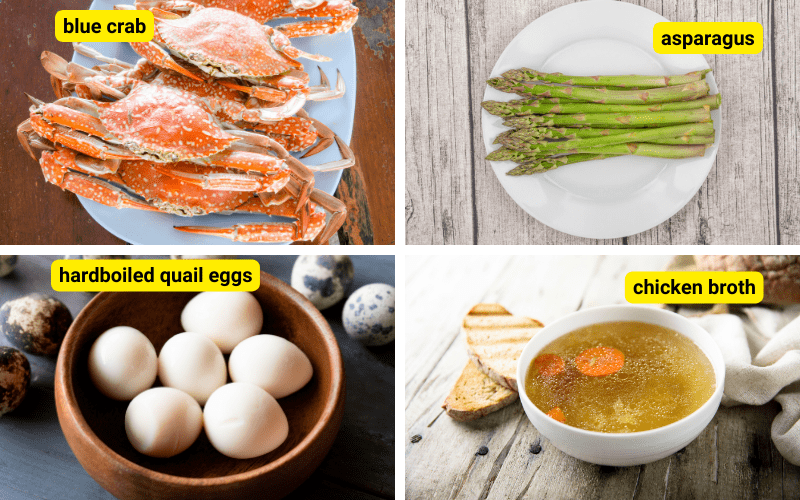
How To Make Sup Mang Cua?
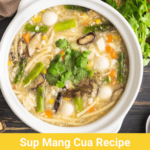
Delve into the exquisite flavors of Sup Mang Cua—a delectable asparagus soup with crab. Discover the perfect harmony of ingredients in this Asian delicacy.
- Large pot
- Soup ladle
- Knife
- Cutting board
- Strainer
- 500g fresh crab (preferably mud crab or blue crab)
- 400g asparagus, trimmed and cut into bite-sized pieces
- 10 hardboiled quail eggs
- 2 beaten egg whites
- 1 liter chicken or vegetable broth
- 1 onion, finely chopped
- 3 cloves of garlic, minced
- 3 tablespoons tapioca flour
- 2 tablespoons cooking oil
- 1 tablespoon fish sauce
- 1 teaspoon sugar
- Salt and pepper to taste
- Fresh cilantro or spring onions for garnish (optional)
Preparing the Asparagus
Trim the woody ends of the asparagus and cut them into bite-sized pieces.
Blanch the asparagus in boiling water for 2-3 minutes until tender-crisp.
Drain and set aside.
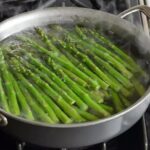
Cooking the Crab
Clean the fresh crab thoroughly, removing any dirt or impurities.
Steam the crab for about 15-20 minutes until cooked.
Once cooled, remove the crab meat from the shells and set aside. Reserve the crab shells for later use.
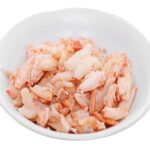
Creating the Soup Base
Heat the cooking oil in a large pot over medium heat.
Add the chopped onion and minced garlic. Sauté until fragrant and golden.
Add the crab shells to the pot and stir-fry for a few minutes to release their flavors.
Pour in the chicken or vegetable broth and bring to a boil.
Reduce the heat and let it simmer for about 20-30 minutes to allow the flavors to meld.
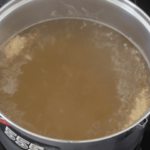
Combining the Ingredients
Strain the soup base to remove the crab shells, onion, and garlic.
Return the strained broth to the pot and bring it to a gentle simmer.
Add the cooked crab meat, asparagus, and hardboiled quail eggs to the soup.
Stir gently to combine all the ingredients.
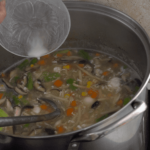
Seasoning and Serving
In a small bowl, mix the tapioca flour with a bit of water to create a slurry.
Slowly add the tapioca slurry to the soup, stirring continuously until it thickens slightly.
Season the soup with fish sauce, sugar, salt, and pepper according to your taste preferences.
In a separate bowl, beat the egg whites until frothy and slowly pour them into the soup while stirring gently to create silky ribbons.
Simmer the soup for another 2-3 minutes until heated through.
Garnish with fresh cilantro or spring onions, if desired.
Serve hot and enjoy the delightful flavors of Sup Mang Cua!
- The ingredient quantities can be adjusted according to personal preference and desired taste.
- Adjust the seasonings and thickness of the soup according to your preference. Feel free to add additional garnishes or herbs for added flavor and presentation.
How much nutritional value of sup mang cua?
Here is a breakdown of the nutritional content, Sup Mang Cua calories per serving:
| Nutrient | Amount Per Serving |
| Calories | 250-300 |
| Protein | 20g |
| Fat | 10g |
| Carbohydrates | 20g |
| Fiber | 4g |
| Sodium | 800mg |
| Vitamin A | 40% DV |
| Vitamin C | 20% DV |
| Calcium | 8% DV |
| Iron | 15% DV |
Key nutrients found in Sup Mang Cua
- Protein: Crab meat provides a significant amount of protein, essential for muscle repair and growth.
- Fiber: Asparagus contributes to the dietary fiber content, aiding in digestion and promoting satiety.
- Vitamins: Sup Mang Cua is a good source of vitamin A and vitamin C, which are important for immune function and maintaining healthy skin.
- Minerals: The dish contains notable amounts of calcium and iron, which support bone health and red blood cell production, respectively.
Health benefits of the ingredients
- Crab: Rich in omega-3 fatty acids, crab meat promotes heart health and provides anti-inflammatory benefits.
- Asparagus: Asparagus is low in calories and high in antioxidants, folate, and vitamin K, supporting healthy digestion and offering potential anti-cancer properties.
Sup Mang Cua for dietary restrictions
- Gluten-Free: Sup Mang Cua is naturally gluten-free, making it suitable for individuals with gluten intolerance or celiac disease.
- Dairy-Free: The soup does not contain any dairy products, making it suitable for individuals with lactose intolerance or following a dairy-free diet.
Allergen considerations
- Shellfish Allergy: Due to the use of crab meat, individuals with shellfish allergies should avoid Sup Mang Cua or substitute the crab with an alternative protein source.
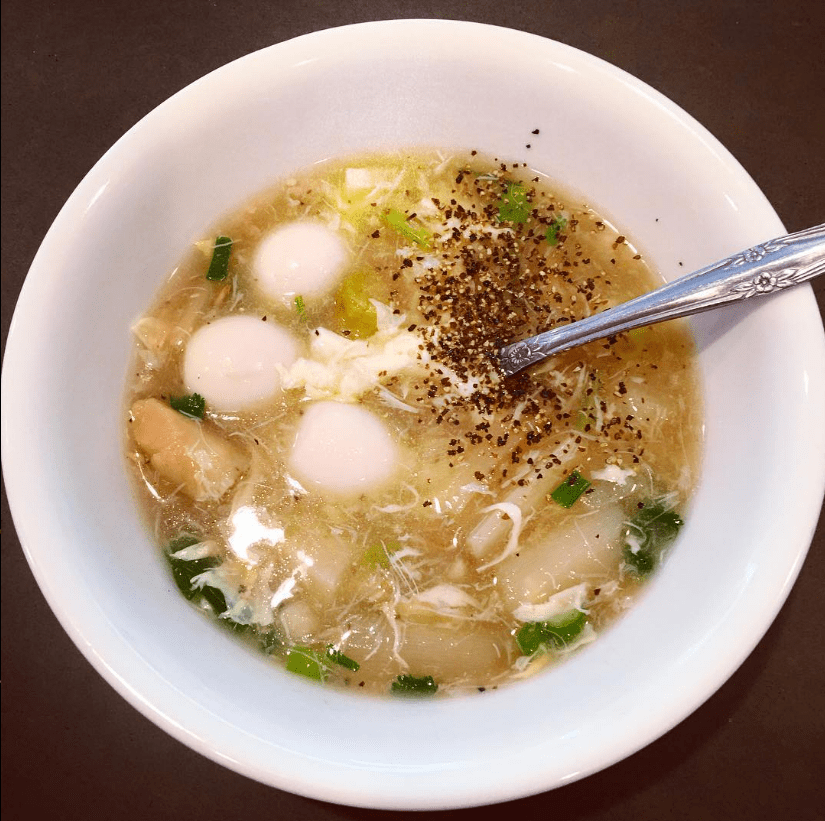
Benefits for specific health conditions or diets
- Low-Calorie: Sup Mang Cua is relatively low in calories, making it a suitable option for those watching their calorie intake or aiming for weight management.
- Anti-Inflammatory: The omega-3 fatty acids found in crab meat can have anti-inflammatory effects, potentially benefiting individuals with inflammatory conditions.
Note: The nutritional values provided are approximate and may vary based on the specific ingredients used and serving sizes.
What to serve with sup mang cua?
Sup Mang Cua pairs well with a variety of accompaniments that complement its flavors. Here are some suggestions on what to serve alongside this delightful soup:
- Fresh Salad: A refreshing salad with crisp greens, cucumber, and cherry tomatoes can provide a contrasting texture and add a vibrant element to the meal. Consider a light vinaigrette dressing to complement the soup’s flavors.
- Pickled Vegetables: Serve a side of pickled vegetables such as carrots, daikon radish, or kimchi. The tanginess of the pickles can provide a refreshing contrast to the rich flavors of Sup Mang Cua.
- Vietnamese Dipping Sauce: Offer a small dish of nuoc cham, a classic Vietnamese dipping sauce made with fish sauce, lime juice, sugar, and chili. This sauce can be drizzled over the soup or used as a dipping sauce for crab meat or other accompaniments.
- Fresh Herbs: Provide a platter of fresh herbs such as cilantro, Thai basil, and mint leaves. These herbs can be added to the soup or used as garnish, enhancing the overall aroma and taste.
Variations of sup mang cua
Sup Mang Cua is a versatile dish that can be adapted and customized based on personal preferences and regional variations. Here are some popular variations of Sup Mang Cua:
- Seafood Medley: Instead of using just crab, incorporate a variety of seafood such as shrimp, scallops, or mussels to create a flavorful seafood medley in the soup.
- Vegetarian/Vegan Version: For those who follow a vegetarian or vegan diet, you can substitute the crab with plant-based alternatives like tofu or tempeh. Use vegetable broth instead of chicken broth and add a variety of vegetables such as mushrooms, carrots, and bell peppers for added texture and flavor.
- Spicy Sup Mang Cua: Add a kick of heat to the soup by incorporating spicy elements like chili peppers, sriracha sauce, or red pepper flakes. Adjust the spiciness level according to your taste preferences.
- Creamy Sup Mang Cua: For a creamy twist, blend a portion of the soup with a handheld blender or food processor to create a smooth and creamy texture. This variation adds a luxurious touch to the dish.
- Coconut Milk Infusion: Replace a portion of the broth with coconut milk to impart a creamy and slightly sweet flavor to the soup. The addition of coconut milk adds richness and depth to the dish.
- Regional Flavors: Explore regional variations of Sup Mang Cua. Different regions may incorporate their own unique ingredients or cooking techniques, offering a diverse range of flavors. For example, some variations may include lemongrass, turmeric, or other local herbs and spices.
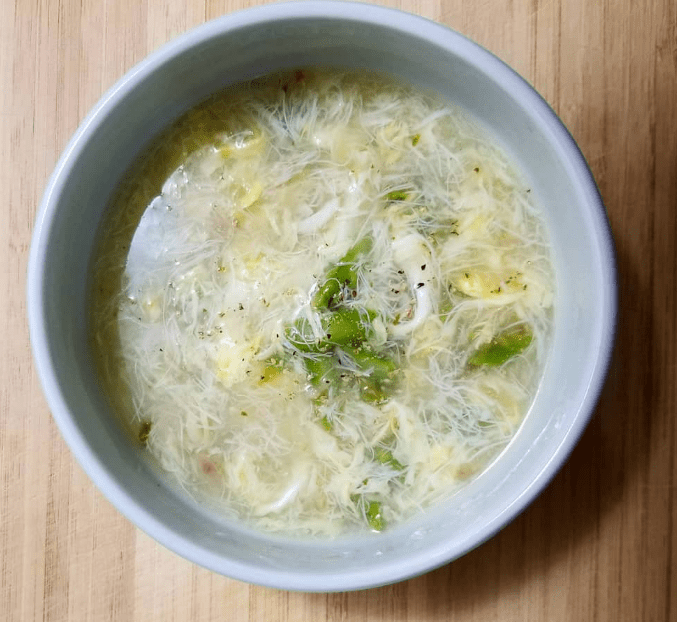
How to store sup mang cua?
To store Sup Mang Cua properly, follow these guidelines:
Refrigeration
- Allow the soup to cool down to room temperature before transferring it to an airtight container. Place the container in the refrigerator.
- Consume the refrigerated soup within 2-3 days to ensure optimal freshness and taste. It’s best to consume it as soon as possible to enjoy its flavors at their peak.
Freezing
If you want to store Sup Mang Cua for a longer period, you can freeze it. Ladle the soup into individual freezer-safe containers, leaving some headspace for expansion during freezing. Seal the containers tightly.
Labeling
Remember to label the containers with the date of preparation before storing them in the freezer. This helps you keep track of the storage time and ensure that you consume the soup within a reasonable timeframe.
Freezer duration
Sup Mang Cua can be stored in the freezer for up to 2-3 months. Beyond that, the quality may start to deteriorate.
Thawing and reheating
- When ready to enjoy the stored soup, thaw it in the refrigerator overnight. Once fully thawed, transfer the soup to a saucepan and gently heat it on the stovetop until heated through.
- Stir occasionally to ensure even reheating.
- Avoid excessive boiling to prevent overcooking the ingredients.
Note: While reheating, you may need to adjust the seasoning, as some flavors can diminish during the freezing process. Taste and adjust the salt, pepper, or other seasonings according to your preference.
Substitute ingredients sup mang cua
If you need to substitute ingredients in Sup Mang Cua, here are some alternatives you can consider:
- Crab Substitute: If you’re unable to find crab or prefer a different seafood, you can substitute it with shrimp, scallops, lobster, or even firm white fish like cod or halibut. Adjust the cooking time accordingly to ensure the seafood is cooked through.
- Asparagus Substitute: If asparagus is not available or not to your liking, you can substitute it with green beans, sugar snap peas, or broccoli florets. These vegetables will provide a similar texture and add a vibrant touch to the soup.
- Vegetarian/Vegan Substitute: To make a vegetarian or vegan version of Sup Mang Cua, you can replace the seafood with plant-based alternatives such as tofu, tempeh, or vegan crab meat substitutes. Use vegetable broth instead of chicken broth for the soup base.
- Gluten-Free Substitute: If you need a gluten-free option, ensure that your ingredients, such as broth and seasonings, are gluten-free. Double-check the labels to confirm.
- Seasoning Alternatives: If you have dietary restrictions or prefer different flavors, you can adjust the seasoning ingredients. For example, use tamari or coconut aminos instead of fish sauce, and substitute sugar with a natural sweetener like maple syrup or agave nectar.
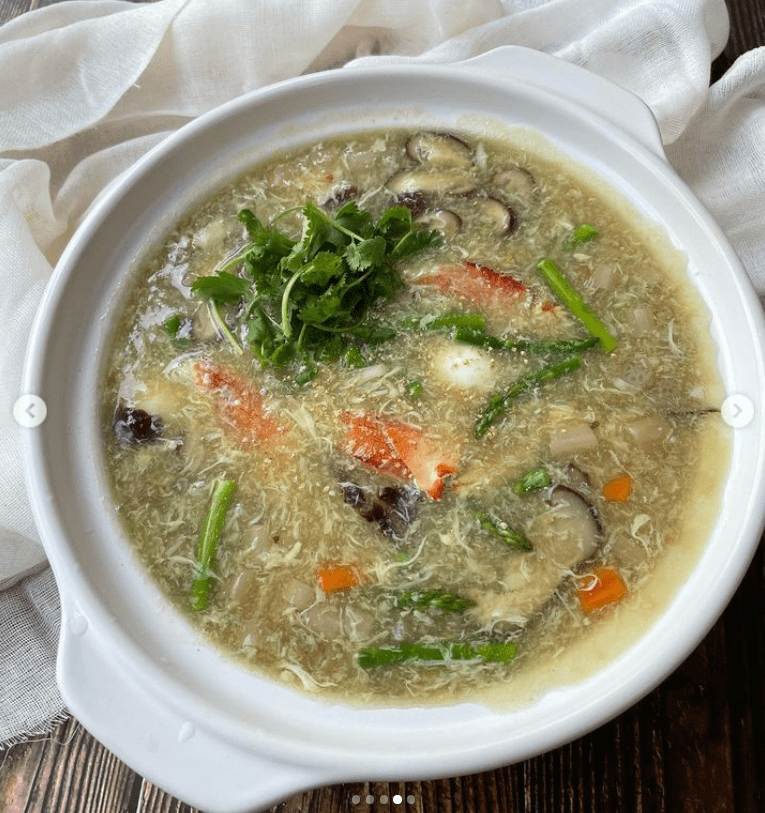
Sustainability and ethical considerations of sup mang cua
Sup Mang Cua, like any dish, can benefit from sustainability and ethical considerations in its ingredients and sourcing. Here are some key points to consider:
Sustainable sourcing of Crab and Asparagus
- When preparing Sup Mang Cua, it is important to choose crab and asparagus that are sourced sustainably. Look for certifications such as Marine Stewardship Council (MSC) for crab or labels indicating sustainable farming practices for asparagus.
- These ensure that the ingredients are obtained in a way that minimizes harm to the environment and supports long-term viability.
Supporting local and responsible suppliers
- Choose to support local and responsible suppliers who prioritize sustainable practices, fair trade, and ethical sourcing.
- By doing so, you contribute to the local economy, reduce the carbon footprint associated with transportation, and encourage sustainable practices within the food industry.
Common mistakes when making sup mang cua
When making Sup Mang Cua, it’s important to be aware of common mistakes to avoid, ensuring the best possible outcome. Here are some common mistakes to watch out for:
- Overcooking the Crab: Be cautious not to overcook the crab, as it can result in a rubbery and tough texture. Follow the recommended cooking time and monitor the crab closely to achieve a tender and succulent consistency.
- Overcooking the Asparagus: Asparagus should be cooked until tender-crisp to maintain its vibrant color and fresh taste. Be mindful of the cooking time and avoid overcooking, which can lead to a mushy texture and loss of flavor.
- Insufficient Seasoning: Sup Mang Cua relies on proper seasoning to enhance its flavors. Make sure to taste and adjust the seasoning as needed, adding salt, pepper, fish sauce, or other seasonings gradually to achieve the desired taste profile.
- Adding Egg Whites Incorrectly: When adding beaten egg whites to create silky ribbons in the soup, ensure that the soup is gently simmering and not boiling vigorously. Adding the egg whites too quickly or stirring vigorously can result in scrambled eggs instead of delicate ribbons.
- Not Straining the Soup: Straining the soup base to remove crab shells, onion, and garlic is crucial for achieving a smooth and refined texture. Failing to strain the soup may result in a gritty or less visually appealing final dish.
- Neglecting Garnishes: Garnishes like fresh cilantro or spring onions add freshness and visual appeal to the soup. Neglecting to add these finishing touches can detract from the overall dining experience.
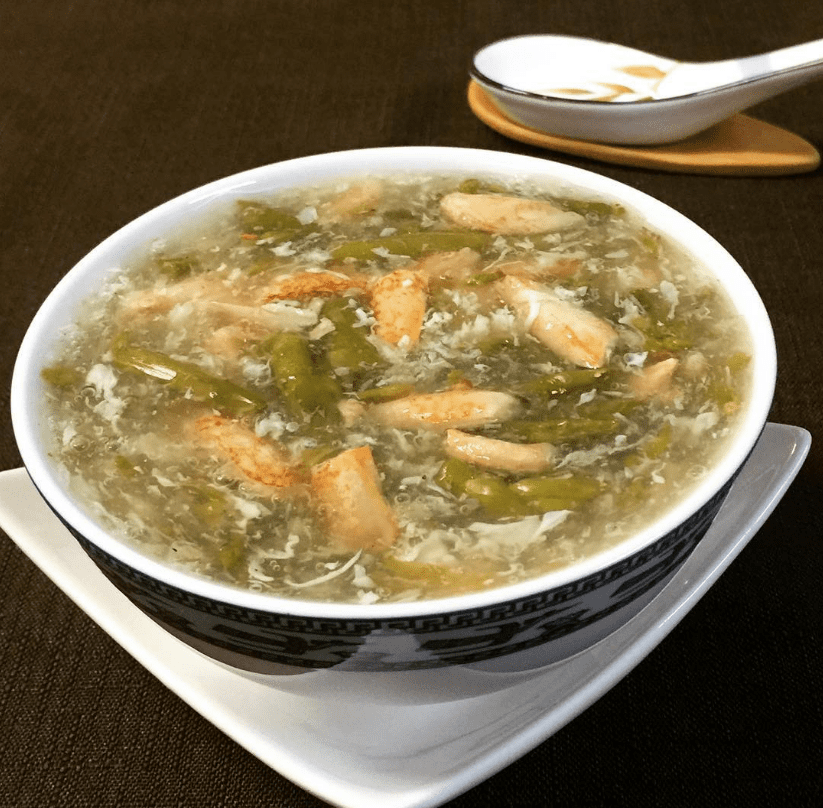
Tips for perfecting sup mang cua
Tips for Perfecting Sup Mang Cua
- Use Fresh Ingredients: Freshness is key to achieving the best flavors in Sup Mang Cua. Choose fresh and high-quality crab, asparagus, and other ingredients to ensure optimal taste and texture.
- Enhance the Aromatics: Boost the aromatic profile of the soup by sautéing the onion and garlic until golden and fragrant before adding the broth. This helps release their flavors and enhances the overall aroma of the soup.
- Don’t Overcook: Be mindful of cooking times to avoid overcooking the crab and asparagus. Cook the crab just until it is cooked through, and the asparagus should be tender-crisp to retain its vibrant color and fresh taste.
- Season Gradually: Season the soup gradually and taste as you go. Start with a small amount of seasonings like fish sauce, salt, and pepper, and adjust according to your preference. Remember, it’s easier to add more seasoning than to fix an overly seasoned soup.
- Utilize Herbs and Citrus: Consider adding fresh herbs like cilantro, Thai basil, or mint to add a burst of freshness. Squeezing a bit of lime or lemon juice into the soup just before serving can also brighten the flavors.
- Troubleshooting Guide:
- If the soup lacks depth of flavor, consider simmering it for a bit longer to allow the flavors to develop.
- If the soup is too thick, gradually add small amounts of broth or water to reach the desired consistency.
- If the soup is too thin, you can mix a small amount of tapioca flour with water to create a slurry and add it to the soup to thicken it.
- If the soup is too salty, dilute it with more broth or water, or balance the flavors with a bit of sweetness or acidity from sugar or citrus juice.
FAQs
Can I use canned asparagus for Sup Mang Cua?
While fresh asparagus is preferred for Sup Mang Cua to maintain its vibrant color and texture, you can use canned asparagus as a substitute if fresh is unavailable. However, note that canned asparagus may have a slightly softer texture and a different flavor compared to fresh.
Is Sup Mang Cua gluten-free?
Sup Mang Cua can be gluten-free if the ingredients and seasonings used are free from gluten. Ensure that the broth, fish sauce, and other flavorings are labeled as gluten-free or do not contain any gluten-containing ingredients.
Also, be cautious when using pre-made stocks or seasonings, as they may have added gluten. Always read the labels and choose gluten-free alternatives if necessary.
Are there any specific cooking techniques for preparing Sup Mang Cua?
While there are no strict cooking techniques for Sup Mang Cua, there are a few key steps to follow. These include sautéing the onion and garlic to release their flavors, simmering the soup base to allow the flavors to meld, and adding the ingredients in a sequence that ensures they are cooked to the desired texture.
It’s important to be mindful of cooking times to avoid overcooking the crab and asparagus.
Can I use vegetable broth instead of chicken broth in Sup Mang Cua?
Yes, you can use vegetable broth as a substitute for chicken broth in Sup Mang Cua. This substitution is suitable for vegetarians or those who prefer a vegetarian version of the soup.
The vegetable broth will provide a different flavor profile, but it can still create a delicious and satisfying soup. Adjust the seasonings accordingly to maintain a balanced taste.
Can I add other vegetables to Sup Mang Cua?
Absolutely! While asparagus is the traditional vegetable used in Sup Mang Cua, you can add other vegetables to customize the dish according to your preferences. Some popular choices include mushrooms, carrots, bell peppers, or even baby corn.
These additions can provide additional flavors, textures, and colors to the soup. Just ensure that the vegetables you choose are compatible with the overall flavor profile of Sup Mang Cua.
How can I make Sup Mang Cua spicier?
If you prefer a spicier version of Sup Mang Cua, there are a few options to add some heat:
- Add chopped chili peppers, such as Thai bird’s eye chili or serrano peppers, to the soup while cooking. Adjust the amount based on your desired level of spiciness.
- Include a dash of chili sauce or hot sauce like sriracha to the soup during cooking or as a garnish.
- Sprinkle red pepper flakes or cayenne pepper into the soup for added spiciness.
- Serve the soup with additional chili condiments or chili oil on the side, allowing individuals to adjust the spiciness according to their preference.
Can I make Sup Mang Cua with a slow cooker?
While Sup Mang Cua is traditionally made on the stovetop, you can adapt the recipe for a slow cooker. However, it’s important to note that the texture of the ingredients, especially the crab, may differ from the stovetop version. To make Sup Mang Cua in a slow cooker, follow these general steps:
- Sauté the onion and garlic in a pan on the stovetop before transferring them to the slow cooker.
- Add the sautéed onion and garlic, crab, asparagus, broth, and seasonings to the slow cooker.
- Cook on low heat for 4-6 hours or on high heat for 2-3 hours until the flavors meld together and the ingredients are cooked to the desired texture.
- Adjust the seasonings before serving.
Can I add noodles to Sup Mang Cua?
While Sup Mang Cua traditionally does not include noodles, you can certainly add them if you desire. Cook the noodles separately according to the package instructions and add them to the soup just before serving.
Keep in mind that adding noodles will alter the texture and overall character of the dish. Thin rice noodles or vermicelli would work well with the flavors of Sup Mang Cua. Adjust the amount of broth and seasonings as needed to accommodate the additional noodles.
Can I use pre-cooked crab meat for Sup Mang Cua?
Yes, you can use pre-cooked crab meat for Sup Mang Cua. Pre-cooked crab meat is convenient and can save time during preparation. Simply ensure that the crab meat is properly thawed if using frozen, and add it to the soup towards the end of the cooking process to warm it through.
Be cautious not to overcook the crab meat, as it is already cooked and can become rubbery if heated for too long.
Can I make Sup Mang Cua spicy and creamy at the same time?
Yes, it is possible to make Sup Mang Cua spicy and creamy simultaneously. Here’s a suggestion to achieve this:
- Add spicy elements such as chili peppers, chili sauce, or red pepper flakes to the soup to give it a kick of heat.
- To create a creamy texture, you can incorporate coconut milk or a small amount of cream towards the end of cooking. Gradually add the creamy element, stirring gently, until you achieve the desired level of creaminess. Be careful not to boil the soup vigorously to prevent curdling or separation of the creamy component.
- Adjust the seasoning and balance the spiciness and creaminess according to your taste preferences.
By combining spiciness and creaminess, you can create a Sup Mang Cua with a delightful interplay of flavors and textures. Experiment with the amounts and types of spices and creaminess to achieve your desired level of heat and creaminess.
Conclusion
To wrap things up, Sup Mang Cua is a delightful Vietnamese soup that tantalizes the taste buds with its unique blend of flavors. The combination of tender crab meat and vibrant asparagus creates a harmonious symphony of tastes and textures. This dish carries cultural significance and is deeply rooted in Vietnamese culinary heritage, often enjoyed during special occasions and gatherings.
Sup Mang Cua has gained popularity not only for its exquisite flavors but also for its versatility. It can be adapted to suit various dietary preferences and can be customized with regional variations and creative twists. Whether enjoyed as a comforting family meal or presented as a gourmet delight, Sup Mang Cua offers a satisfying and memorable dining experience.
From the careful selection of fresh ingredients to the proper balance of seasonings, each step plays a crucial role in perfecting this soup. Expert tips and troubleshooting guides can help ensure the flavors are enhanced and any potential issues are addressed.
So, indulge in the flavors, savor the aroma, and appreciate the cultural heritage that Sup Mang Cua represents. It’s a soup that brings people together, celebrates the richness of Vietnamese cuisine, and invites you to experience a truly delightful culinary journey. Enjoy every spoonful of this exquisite delicacy, and let Sup Mang Cua captivate your senses with its unique and enchanting flavors.